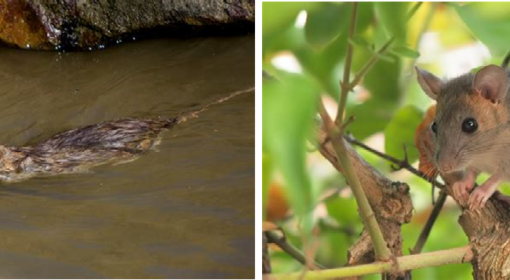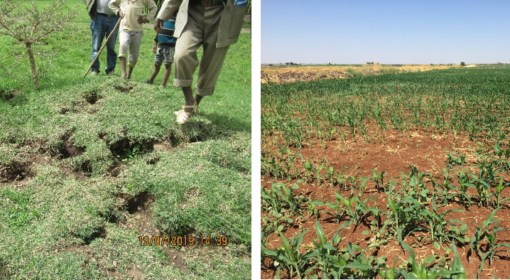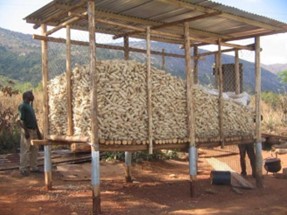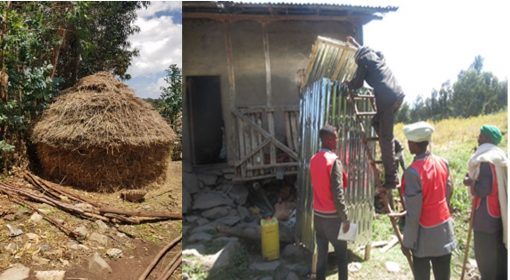Luwieke Bosma (MetaMeta), Anushree Mitra (MetaMeta), Dikhyani Konwar (PRADAN), Poulomi Mallick (PRADAN), and Saroj Yakami (MetaMeta) and Dr Neena Singla (Punjab Agricultural University)
This is the first blog out of two where we will learn about rodent characteristics in four villages in Madhya Pradesh, India. The people in these villages taught us about the rodent species and how these small mammals damage crops at an average 25%. In the next blog we will dive deeper into rodent management options. Seeking to understand the traditional systems and how Ecologically-Based Rodent Management methods could be integrated and by who.
Rodents are a major but often unseen problem in food systems. Despite rodents negatively impacting human health, welfare and food security, their management remains neglected by development policies. More than 400 million people are affected by rodent-associated pathogens (e.g., Lassa fever, plague, leptospirosis, typhus, hantaviruses) each year [1,2]. Field and post-harvest agricultural losses may reach 100% during rodent outbreaks, with chronic global crop damages estimated at 5-25% for major cereal and horticultural crops. Globally, an additional ~279 million people would be nourished with cereals gained from effective rodent management [3].

People adversely affected by rodent pests are often the poorest and most marginalised since their housing and storage are made of local material easily breached by rodents, and they have little access to knowledge and methods to manage rodents effectively. For low-income families, damage caused by rodents can amount to 2-3 months of food or a substantial loss of income and health. Men and women are both affected by rodent problems; however, some commodities and crops vulnerable to rodent attacks have a strong link to women’s livelihoods and source of income, particularly stored products and home-garden vegetables.
Box 1: Rat Facts
- Rats multiply quickly, from one pair of rats, 1250 rats can be born in one year.
- Rats greatly depend on the availability of good quality food and shelter to breed
- Rats all over the world cause 15-25% of damage to crops in the field and in store
- Rats usually move within 30-100 meters of their shelter each day, depending on food/mate availability.
- Rats play a role in the transmission of more than 60 types of diseases.
- Rats are very clever animals and can learn to avoid measures taken against them.
In India, major changes in agricultural systems have increased the rodent problem in recent decades. The major rodent pests prevalent are Bandicota bengalensis, Milardia meltada, and Mus booduga. It is reported that the overall losses of grain to rodents in India were approximately 25% in pre harvest and 25-30% in post harvest situations bringing the loss to at least US$ 5 billion annually in stored food and seed grain in India [4].
Generally, it is assumed that tribal communities in India had less incidence, due to predatory feeding habits by these communities, i.e. catching rats for food. However, based on anecdotal evidence this is doubtful, as people shared they can lose a quarter to half of their crops to rodents. Furthermore, we found there is a big gap in data and knowledge on rodents in the state of Madhya Pradesh.
Therefore we initiated 4 Knowledge Attitude Perceptions (KAP) semi-structured surveys in 4 different villages in Madhya Pradesh, to start closing the knowledge gaps. The KAPs were conducted in a Focus Group Discussions (FGD) setting with 10-20 village representatives, both men and women. The villages visited are Dhamanpani, Kumharra, Dudhera and Paudi; which are dominated by Gond and Baiga tribes. Their main livelihood sources are agriculture, non-timber forest produce, labour work and livestock rearing. Rats are considered a serious problem in all villages, both in homesteads and in fields.

Rodent species
Many different rodent species were identified by community, indicating the rich knowledge they have of these animals.
- The Tharela/Tareli rat (likely the Bandicota bengalensis, lesser bandicoot rat) was called the ‘boss of the rats’, the strongest rat around that can even fight snakes.. It is a large rat, lives alone, is active at night and weighs 250-500 grams. One animal itself can destroy 20% on a 10 decimal (1 acre = 100 decimal) land. It does not only eat whatever it cuts, it stores a lot of food in the burrows that can be up to 3 feet deep. Out of 100 cuts it may only eat 10, that other 90 is stored in the burrows.
- Kotheli species (likely the Indian gerbil, Tatera indica) is found in the forest, they live in groups, and are night-active. Its belly is white, the upper is light brown, with a white tail. They can make a very big hole and pierce holes in foundations of houses.
- Chaura (either soft furred field rat, Millardia meltada or Indian bush rat, Golunda ellioti) is also found in the forest and is night-active. They have a white tail, resemble Kotheli, but are a bit smaller in size. They live under small bushes.
- Gharwala, also called chuha (likely the house rat, Rattus rattus), the most common rat to see.
- Chote (likely a field mouse, Mus booduga, or house mouse, Mus musculus / Mus domesticus), very small in size but they can cut the stems of paddy rice.
- Other forest species include: Bhaisadal and Baanskata. Other species mentioned are: Gharuli, Ghuus (shrew, Suncus murinus), Bandrachote, and Chuchundar.

How much is the damage?
Frequent damage occurs both at home as well as at field, especially during harvest time for the Kharif (October-November) and Bari crop (March-April). During those times there is ample food available at the field, and in the storage. The household items that are damaged in all the houses include: clothes, papers, electric wires, floors, unbaked walls, plastic drums and food containers, and rats bite small chicks.

The following table shows the damage for the village of Kumharra, on average the overall damage in all the villages is 25% on average. The crops with highest damage are maize and paddy rice.


Communities shared that rats literally eat everything that a human eats. Though rats also have dietary preferences, especially regarding the crop stage. Pulses for instance are eaten by rats when the plants are very small, in seedling stage, this is when they are a little soft and are very juicy. To reach the sweet maize, rats climb up all the way to the top to eat from the cob, or rats eat it when it is stored at the house. Leafy vegetables grown in Kharif season are eaten when they are stored in dry form.
Paddy rice is clearly a favourite of rats and eaten at any growth stage, though harvest time is when most of the crop is cut by rodents. Reason being that rice is often cultivated through the transplanting period, whereby the fields are put under water. Rats generally do not like water, so they stay put, until the water dries up and harvesting begins, then rats grab their chance. Farmers share that rat populations are growing incessantly since they started with paddy rice cultivation. At the time when farmers only cultivated millet and finger millet, rats were also a problem, but not as big as today. Wheat is not grown as much in the villages, but people share that rats really enjoy wheat, even over paddy rice. The rats wait until seeds start to come out from the wheat plant, that is when they come to take advantage.
The two basic requirements for rodents to thrive is to have enough food and a space to live and hide, while during their movement to and from, they remain unseen from natural predators. As we have seen, there is a diversity of food available for the rats. On top of that, habitat options are plenty in the villages we visited, there are ample soil- and stone-bunds where rats take shelter. From their shelter they can directly access the crops in-field. Stone bunds in bari and khet lands are different. In khet you first put up soil, on top you add stones, so this is a water conservation structure. In bari you just pile up stones to remove them from the field. Furthermore, rodents can be found in vacant houses, old houses are good hiding places for rats. People shared that most likely a lot of rats will live in those houses. Rats are also found in a majority of residential houses under the roof, and along walls and in floors. Rats can gnaw through baked clay, and can therefore enter houses by digging through the walls or floors. During the dry and lean periods rats often take shelter in homestead lands, they stay either in the field bunds or burrows.
Main lessons:
Traditional knowledge of communities on the different species and their behaviour is very rich. In Rodent Green we believe that to manage rodent populations and minimise their negative impacts, we need to clearly understand the ecological requirements of the rodents. Rodent populations are known to grow exponentially given the right conditions. Therefore we must together assess how environmental circumstances are created in which rodent populations expand beyond acceptable levels.
It is critical to understand the huge losses incurred by rodents, it is something that is normally not shared, only after making the calculations together the real losses come out, which can surpass losses due to other factors. It brings a direct loss to food availability for the family, while there are Ecologically-Based Rodent Management (EBRM) methods that can prevent rodents access to food and shelter, thus safeguarding crops and assets. In the next blog on rodent management options we will dive deeper into traditional management methods and how EBRM can be integrated.
Do you want to know more? Contact Luwieke (lbosma@metameta.nl) or have a look at www.rodentgreen.com

References:
[1] Colombe S, Jancloes M, Rivière A, et al. (2019). A new approach to rodent control to better protect human health: First international meeting of experts, WHO, Pan American Health Organization. 197-203.
[2] Meerburg BG, Singleton GR, Kijlstra A (2009). Rodent-borne diseases and their risks for public health. Crit. Rev. Microbiol, 35:221–270.
[3] Meerburg BG, Singleton GR, Leirs H (2009). The Year of the Rat ends – time to fight hunger! Pest Manag, 65:351-352.
[4] Raghav, Dr & Rai, Deepak. (2021). Rodent problem in rainfed rice in North Chota Nagpur region of Jharkhand. Indian Journal of Entomology. 83. 10.5958/0974-8172.2020.00252.7.



